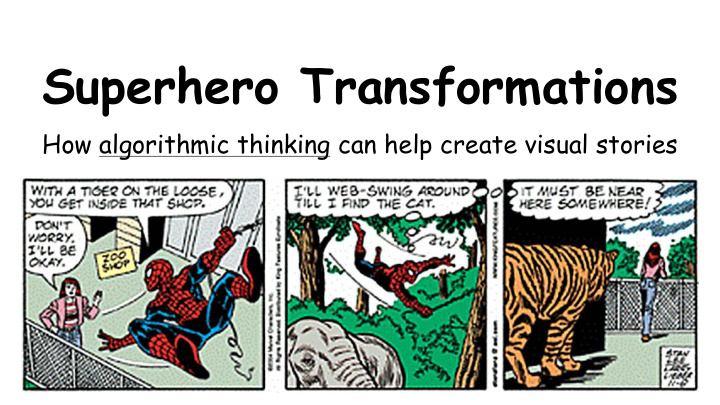



Superhero Transformations How algorithmic thinking can help create visual stories
Introduction to Computational Thinking: Vocab Abstraction : Ignoring unimportant details in something complicated In this project: Simplifying the design of your superhero with basic shapes You also used abstraction in Ms. Hauber’s class when making 3D atomic models! Decomposition : Breaking down a big problem into smaller pieces In this project: Dividing your superhero story into four comic panels Algorithmic thinking : Creating or using a list of steps needed to complete a task In this project: Finding the series of geometric transformations between panels
Project overview You are going to create a superhero comic strip! To do this, you will: Design your own superhero ● Simplify your superhero using basic shapes ● Write a short story about your superhero ● Place your superhero in the first of four comic ● panels, and then use geometric transformations to get your superhero into the other three panels Finalize your comic strip with other characters, ● props and scenery
Step 1: Create your superhero Come up with a name and one or two superpowers Sketch your superhero in the square provided
Step 2: Use abstraction to simplify your design Recreate your superhero with a simple geometric shape with five or fewer labeled vertices. Your vertices must land on the intersection of two grid lines.
Step 3: Write your superhero story Choose one of the following three story ideas, then write out your story in a short paragraph, at least 5 complete sentences. The first day your superhero discovers their ● powers. Things get a little out of control! A supervillain (of your own design) has ● kidnapped your best friend - how will your superhero free them? An alien army is invading Tacoma - how will ● your superhero stop them and save the world?
Step 4: Use decomposition to break down your story Your story needs to be broken down into four comic panels. Each panel needs to include your superhero. Each panel can also include: Other characters ● Props and scenery ● Speech or thought bubbles ● Captions or sound effects ●
Step 5: Cut out your hero and put him or her in Panel 1 Trace your simplified hero design into the first panel, making sure your verticles land on grid lines. Record the coordinates of each vertex on your handout
Step 6: Use algorithmic thinking to move your hero For each panel, come up with one or more transformation (translation, reflection or rotation) to get your superhero where you want them in the panel. You must use at least one reflection OR one rotation in your project ● You must write your steps, including what transformation(s) you did and ● the coordinates of each vertex in each panel Use the cutout to help visualize where you want your hero in each panel ● Example : To translated by 3 units in the y-direction (up) get my hero from Panel 1 to Panel 2, I... A 2 : 5 , 15 B 2 : 0 , 18 C 2 : -5 , 13 D 2 : -9 , 4 E 2 : ,
Step 7: Complete your comic! Looking back at your story from Step 3 and your panel sketches from Step 4, fill in the remaining details in each panel. These could include: Other characters (good guys, bad guys or ● innocent civilians) Scenery (buildings, trees, cars…) ● Word or thought bubbles ● Captions describing what’s happening in ● each panel
Project Component Point Value Planning steps completed: ● [Step 1] Superhero name and superpowers listed ● [Step 2] Simplified geometric superhero drawn and cut out _______/25 ● (5 points per step) [Step 3] Story written in short paragraph form ● [Step 4] Each panel sketched with the superhero included in each ● [Step 5] Starting coordinates correctly identified Final comic panels completed _______/12 (3 points per panel) The steps between each panel listed in the table include: _______/20 ● (4 points per step) correct geometric transformations ● coordinates for the superhero’s vertices Neatness/organization/effort ● Handwriting is legible (able to be read) ________/8 ● (2 points per Colorful illustrations requirement) ● Creative illustrations ● Name and block are written in the correct place
Recommend
More recommend